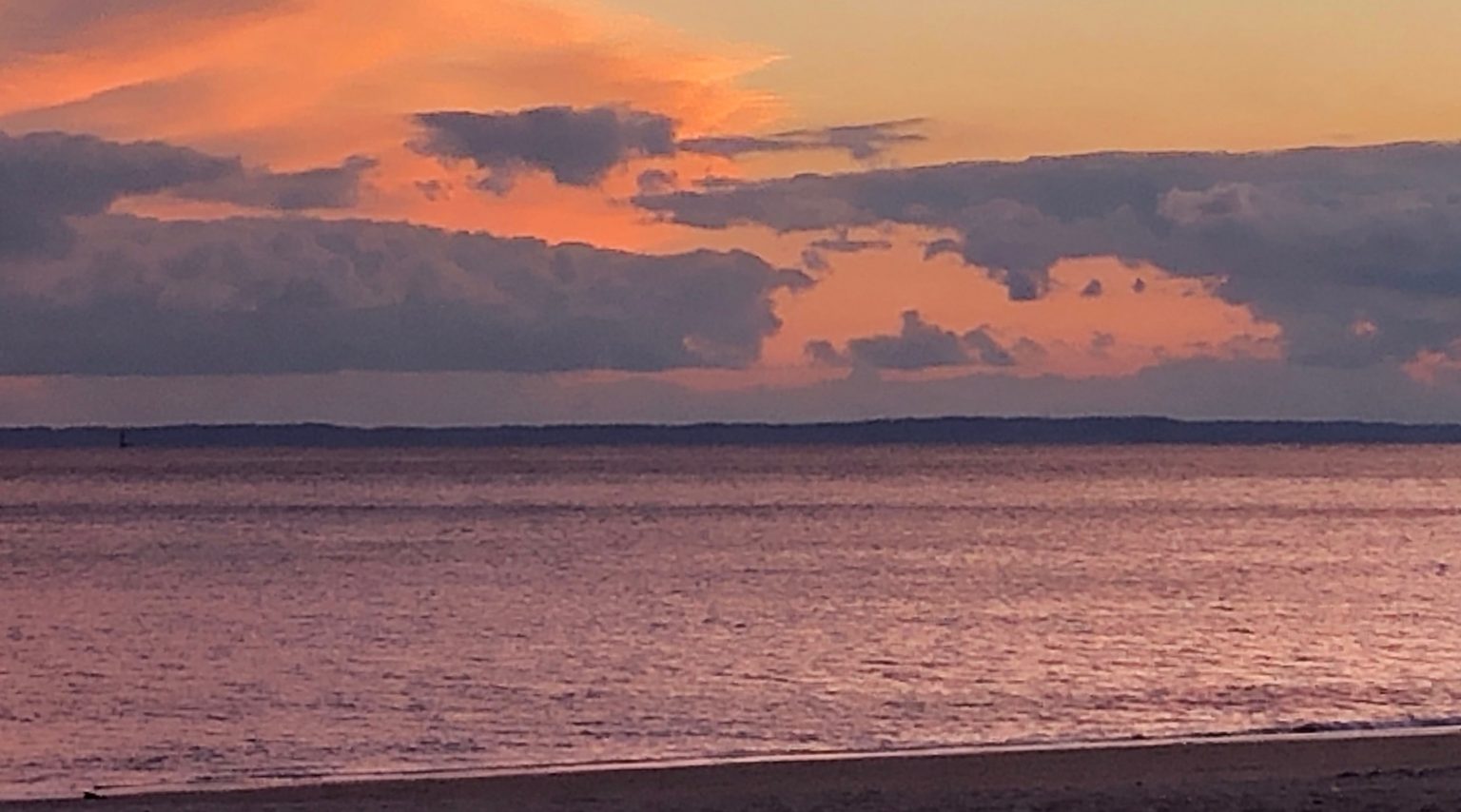Opinion: Love Justice And Climate Change. White Supremacy And Climate Change In The U.S.

Photo: A sunset at Brighton Beach, Brooklyn, NY. Photo: Russ Vernon-Jones.

Seventy percent of the U.S. population is worried about climate change. Scientists are clear about what needs to happen. It is possible and doable, yet it isn’t happening. Clearly there are forces at work preventing our government, businesses, and society from turning to face the climate crisis and do everything that needs to be done as rapidly as possible. What is it that is pushing the other way? This is a complex question with many answers, but in this post I’d like to look at the role that white supremacy is playing. My goal is not to blame white people, but to help us all to deepen our understanding of what is happening so we can all be more effective in contributing to the changes that are needed for our planet to remain a habitable home for human beings. To say that white supremacy is systemic in the U.S. is not to say that it determines or describes every situation and relationship. It doesn’t. Yet it has been a powerful systemic force throughout our history, up to and including the present.
Domination And An Ideology Of Superiority
When white settlers first came to this continent they rather quickly started dominating the indigenous population and enslaved Africans. Some settlers came seeking religious freedom. More came seeking better economic opportunities. Many had been oppressively mistreated in the hierarchical societies of Europe and this set them up to mistreat others when the opportunity arose. The chance to feel “better than” and seek to profit at others’ expense was irresistible to many.
The English settlers, especially, adopted an ideology of superiority–that they were culturally and morally superior to both the Indigenous people and Africans. They took land for themselves that the native people had lived on for thousands of years, killed many natives, and drove others off their land. They instituted a violent system of slavery that cruelly dominated and exploited black Africans and their descendants. Not everyone participated in these atrocities, of course, but white society as a whole, came to tolerate, if not promote, both the forcible taking of native land and slavery.
Domination Of The Land
Domination of others extended to include domination of the land. The Europeans brought with them the Christian Bible that commanded them to “subdue” the earth and have “dominion … over every living thing that moves on the earth.” (Genesis 1:28) They viewed the earth as a resource to be exploited in their pursuit of wealth. This stands in contrast to the Indigenous people who viewed, and continue to view, the land, water, and air as cherished relations and who had lived in harmony with their environment, preserving a sustainable balance with nature throughout millennia.
Entitlement
The ideology of superiority produced a sense of entitlement. White people felt entitled to dominate non-white people, entitled to take their land and labor, entitled to become rich, and entitled to make decisions that affected everyone, and to establish institutions and practices, without regard for the viewpoints or interests of anyone who wasn’t white.
Pursuit Of Wealth
Early wealth accumulation by white people was built on the theft of native land and the forced labor of enslaved people of African heritage. As it became clear that slavery could generate huge profits for white owners, racism was invented to justify violently enslaving black Africans. While the ideology of superiority may have first been about being European or Christian, over time, the notion of whiteness and the superiority of white people became preeminent.
Central to all this was viewing Indigenous and African people as less than fully human. This meant that they had no rights that needed to be respected. It meant that white people could pursue wealth and domination without regard for the effects of their action on those who weren’t white (and by extension, without regard for the effect on the environment).
Bribing White Working People To Side With Wealthy Whites
Of course, only a small number of white people became wealthy. How do you get a majority of the population to support a system that so disproportionately benefits a few? In what is sometimes termed the “racial bribe” middle and lower class white people were granted special privileges that were denied to Blacks. This divided white workers and black slaves and workers from each other, led whites to side with the wealthy and identify as white, and “feel better” than Black people.
While it is far from universal, that “bribe” originating in the late 1600’s, is still widely effective today. However downtrodden and impoverished some white people are, they still have their supposed superiority to Black people to hold onto as a source of dignity and self-respect. This has effectively prevented working- and middle-class people of all races from uniting across racial differences to insist on redistributing the wealth. (This is part of the reason for the relative silence around the fact that today the top 10% (which is mostly white) has 70% of the wealth in the U.S. and the bottom 50% (of all races) has only 2% of the wealth of the nation.)
Significant Progress, Yet…
We have made significant strides toward greater racial equality and many white people are committed to full respect, equity, and inclusion for people of all races. Nonetheless, white people still hold the overwhelming majority of political and economic power in this country today. White supremacy is still the prevailing system in the United States. While good antiracism work has helped to liberate the minds of many white people enough that we are less often tripped up by racism, all of us are vulnerable here. Freeing our minds of racism is an ongoing process. Notions of white superiority and entitlement are still deeply embedded in the consciousness of millions of white people. These notions are available to be manipulated, both directly and subliminally, by power-seeking politicians and their supporters.
Fear
One of the mechanisms of control that helped buttress slavery was to instill fear of Black people in the white population. Fear of “savages” was part of what helped get white people to participate in, and/or support, killing native people. Fear of Global Majority and Indigenous people resides today in the consciousness of many white people. It’s being brought more to the fore as the U.S. moves rapidly toward people who are not white being a majority of the population–probably by 2045. There appears to be a developing consensus in the Republican party that could be expressed this way: “If whites are going to be a minority, then majority rule is no longer in our interest.” Thus we get the current systematic attempt to undermine democratic elections.
A Key Connection Between White Supremacy And Climate Change
Climate Action Requires A Strong Federal Government
Doing our part in the U.S. to end the climate crisis requires very large central government expenditures, regulations, and other actions. This runs directly counter to the right-wing agenda of the last 40 years to make the federal government smaller and weaker. They’ve systematically tried to shrink the federal government so it does not tax and regulate growing wealth and so it doesn’t interfere with the racial divisions and widespread inequality of the system founded on the “racial bribe.”
Conversely, those who want strong government action to address the climate crisis support higher taxes on the wealthy, regulations that put the common good ahead of private profit, and economic and social policies that build a multi-racial coalition of working- and middle-class people. The political battle over climate change in the U.S. has been as much about these conflicting views of the role of the federal government as it has been about climate science and policy.
White supremacy wants a federal government too weak to advance civil rights, too weak to regulate businesses (to reduce emissions, to promote public health or anything else), too weak to levy the taxes and make the huge expenditures needed to transition to a sustainable energy system. It wants a federal government that does not interfere with the immense wealth accumulation of the 1% or racial dynamics that support it.
Progressive forces that support bold climate action, increasingly understand that building sustainable society means building a society that works for all people in the areas of housing, health, employment, wealth, civil rights, voting rights, safety, and justice as well as rapidly transforming our economy to one that doesn’t emit greenhouse gasses. This means not allowing white supremacy to determine the direction of our country.
Action Steps And Sharpening Our Analysis
This is not to say that all opposition to climate action originates in racial hatred or prejudice. But the system of white supremacy is a major force in life in the U.S. today. It’s important for us to understand this and include it as one key piece of our analysis of the situation we are in if we are going to be effective in addressing the climate crisis.
In “How White People Can Help Dismantle White Supremacy” I recommend 12 specific action steps for white people. In addition, I think it will be useful for each of us to develop a deeper understanding of the role white supremacy is playing in the climate crisis, to talk with others about this, and to ask others how they see things. Sharpening our analysis is important. If we don’t have a correct analysis, we are unlikely to take the most effective actions.
Russ Vernon-Jones was principal of Fort River School 1990-2008 and is currently a member of the Amherst Community Safety Working Group and of the Steering Committee of Climate Action Now-Western Massachusetts. He blogs regularly on climate justice at www.russvernonjones.org.
Photo credit: a sunset at Brighton Beach, Brooklyn, NY – by Russ Vernon-Jones.
